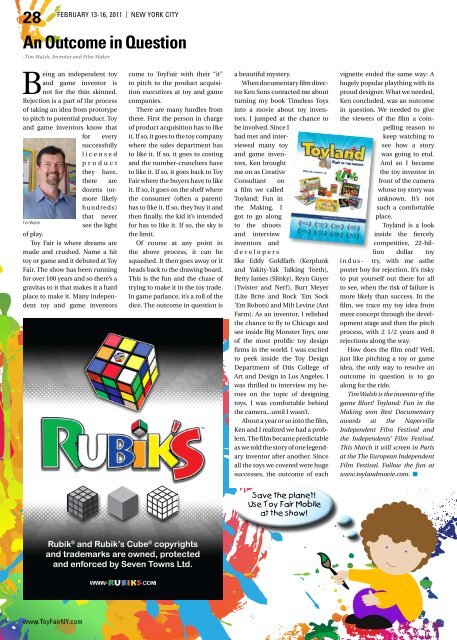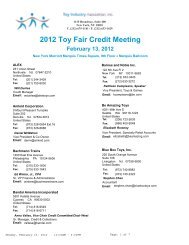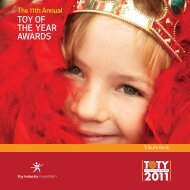ATTENDEE GUIDE - Toy Industry Association
ATTENDEE GUIDE - Toy Industry Association
ATTENDEE GUIDE - Toy Industry Association
Create successful ePaper yourself
Turn your PDF publications into a flip-book with our unique Google optimized e-Paper software.
28 FEbRuARY 13-16, 2011 | NEw YORk cITY<br />
An Outcome in Question<br />
-Tim Walsh, Inventor and Film Maker<br />
Being an independent toy<br />
and game inventor is<br />
not for the thin skinned.<br />
Rejection is a part of the process<br />
of taking an idea from prototype<br />
to pitch to potential product. <strong>Toy</strong><br />
and game inventors know that<br />
for every<br />
successfully<br />
l i c e n s e d<br />
p r o d u c t<br />
they have,<br />
there are<br />
dozens (ormore<br />
likely<br />
hundreds)<br />
that never<br />
Tim Walsh<br />
see the light<br />
of play.<br />
<strong>Toy</strong> Fair is where dreams are<br />
made and crushed. Name a hit<br />
toy or game and it debuted at <strong>Toy</strong><br />
Fair. The show has been running<br />
for over 100 years and so there’s a<br />
gravitas to it that makes it a hard<br />
place to make it. Many independent<br />
toy and game inventors<br />
come to <strong>Toy</strong>Fair with their “it”<br />
to pitch to the product acquisition<br />
executives at toy and game<br />
companies.<br />
There are many hurdles from<br />
there. First the person in charge<br />
of product acquisition has to like<br />
it. If so, it goes to the toy company<br />
where the sales department has<br />
to like it. If so, it goes to costing<br />
and the number-crunchers have<br />
to like it. If so, it goes back to <strong>Toy</strong><br />
Fair where the buyers have to like<br />
it. If so, it goes on the shelf where<br />
the consumer (often a parent)<br />
has to like it. If so, they buy it and<br />
then finally, the kid it’s intended<br />
for has to like it. If so, the sky is<br />
the limit.<br />
Of course at any point in<br />
the above process, it can be<br />
squashed. It then goes away or it<br />
heads back to the drawing board.<br />
This is the fun and the chase of<br />
trying to make it in the toy trade.<br />
In game parlance, it’s a roll of the<br />
dice. The outcome in question is<br />
Rubik ® and Rubik’s Cube ® copyrights<br />
and trademarks are owned, protected<br />
and enforced by Seven Towns Ltd.<br />
www.<strong>Toy</strong>FairNY.com<br />
a beautiful mystery.<br />
When documentary film director<br />
Ken Sons contacted me about<br />
turning my book Timeless <strong>Toy</strong>s<br />
into a movie about toy inventors,<br />
I jumped at the chance to<br />
be involved. Since I<br />
had met and interviewed<br />
many toy<br />
and game inventors,<br />
Ken brought<br />
me on as Creative<br />
Consultant on<br />
a film we called<br />
<strong>Toy</strong>land: Fun in<br />
the Making. I<br />
got to go along<br />
to the shoots<br />
and interview<br />
inventors and<br />
d e v e l o p e r s<br />
like Eddy Goldfarb (Kerplunk<br />
and Yakity-Yak Talking Teeth),<br />
Betty James (Slinky), Reyn Guyer<br />
(Twister and Nerf), Burt Meyer<br />
(Lite Brite and Rock ’Em Sock<br />
’Em Robots) and Milt Levine (Ant<br />
Farm). As an inventor, I relished<br />
the chance to fly to Chicago and<br />
see inside Big Monster <strong>Toy</strong>s, one<br />
of the most prolific toy design<br />
firms in the world. I was excited<br />
to peek inside the <strong>Toy</strong> Design<br />
Department of Otis College of<br />
Art and Design in Los Angeles. I<br />
was thrilled to interview my heroes<br />
on the topic of designing<br />
toys. I was comfortable behind<br />
the camera...until I wasn’t.<br />
About a year or so into the film,<br />
Ken and I realized we had a problem.<br />
The film became predictable<br />
as we told the story of one legendary<br />
inventor after another. Since<br />
all the toys we covered were huge<br />
successes, the outcome of each<br />
Save the planet!<br />
Use <strong>Toy</strong> Fair Mobile<br />
at the show!<br />
vignette ended the same way: A<br />
hugely popular plaything with its<br />
proud designer. What we needed,<br />
Ken concluded, was an outcome<br />
in question. We needed to give<br />
the viewers of the film a compelling<br />
reason to<br />
keep watching to<br />
see how a story<br />
was going to end.<br />
And so I became<br />
the toy inventor in<br />
front of the camera<br />
whose toy story was<br />
unknown. It’s not<br />
such a comfortable<br />
place.<br />
<strong>Toy</strong>land is a look<br />
inside the fiercely<br />
competitive, 22-billion<br />
dollar toy<br />
indus- try, with me asthe<br />
poster boy for rejection. It’s risky<br />
to put yourself out there for all<br />
to see, when the risk of failure is<br />
more likely than success. In the<br />
film, we trace my toy idea from<br />
mere concept through the development<br />
stage and then the pitch<br />
process, with 2 1/2 years and 8<br />
rejections along the way.<br />
How does the film end? Well,<br />
just like pitching a toy or game<br />
idea, the only way to resolve an<br />
outcome in question is to go<br />
along for the ride.<br />
Tim Walsh is the inventor of the<br />
game Blurt! <strong>Toy</strong>land: Fun in the<br />
Making won Best Documentary<br />
awards at the Naperville<br />
Independent Film Festival and<br />
the Independents’ Film Festival.<br />
This March it will screen in Paris<br />
at the The European Independent<br />
Film Festival. Follow the fun at<br />
www.toylandmovie.com. n





